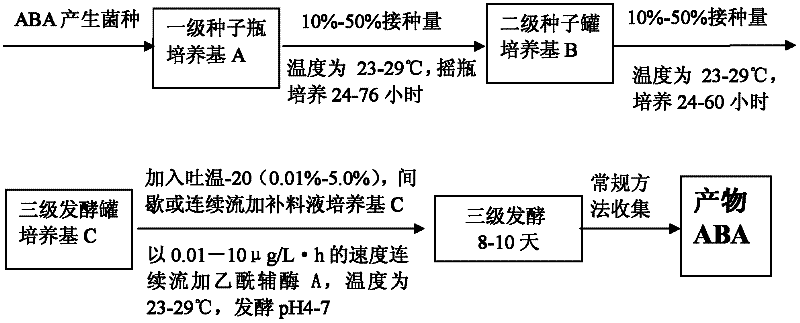Method for efficiently preparing natural abscisic acid
A natural abscisic acid, high-efficiency technology, applied in the field of microbial fermentation, can solve the problems of low production cost, high production cost, low fermentation yield, etc., achieve the effect of reducing energy consumption, reducing production cost, and improving dissolved oxygen status
- Summary
- Abstract
- Description
- Claims
- Application Information
AI Technical Summary
Problems solved by technology
Method used
Image
Examples
Embodiment 1
[0116] Use 25 1000ml Erlenmeyer flasks, each with 300ml medium A, sterilize at 120°C, inoculate the activated abscisic acid high-yielding strain Botrytis cinerea TBC-20 (CGMCC No.4645) spore suspension after cooling, and place at 25°C Shake flasks were incubated at temperature for 24-46 hours. Inoculate the cultured primary seed liquid into a 100 liter fermenter (secondary seed tank) with 50 liters of medium B inside by 13%-15% inoculum, and cultivate it with aeration and stirring at a temperature of 26°C-28°C for 24 -40 hours.
[0117]Use a 1-ton fermenter for three-stage fermentation. The medium C in the tank is about 500L. After sterilizing with conventional high-pressure hot steam sterilization, inoculate the seed liquid of the second-stage tank at 10%-15% of the inoculum. 26°C-27 After 20-40 hours of fermentation with aeration and stirring at ℃, Tween-20 was added at one time, and the amount added was 0.05% of the volume of the fermentation broth, and then feeding medium...
Embodiment 2
[0123] Use 50 1000ml Erlenmeyer flasks, each with 300ml medium A, sterilize at 120°C, inoculate the activated abscisic acid high-yielding strain Botrytis cinerea TBC-20 (CGMCC No.4645) spore suspension after cooling, and place at 23°C Shake flasks were incubated at -25°C for 24-33 hours. Inoculate the cultured primary seed liquid into a 200 liter fermenter (secondary seed tank) with 100 liters of medium B inside by 15%-18% inoculation amount, and cultivate it with aeration and stirring at a temperature of 24°C-26°C for 24 -30 hours.
[0124] Use a 1-ton fermenter for the third-stage fermentation. The medium C in the tank is about 500L. After sterilization by conventional high-pressure hot steam sterilization, inoculate the seed liquid of the second-stage tank according to the inoculation amount of 20%-25%. After 15-24 hours of fermentation with aeration and stirring at 26°C, Tween-20 was added at one time, and the amount added was 0.08% of the volume of the fermentation broth...
Embodiment 3
[0130] Use 30 1000ml Erlenmeyer flasks, each containing 300ml medium A, sterilize at 120°C, inoculate the activated abscisic acid high-yielding strain Botrytis cinerea TBC-10 (CGMCC No.1889) spore suspension after cooling, and place at 27°C Next, shake flasks for 24-33 hours. Inoculate the cultured primary seed liquid into a 100 liter fermenter (secondary seed tank) with 50 liters of medium B inside by 15%-20% inoculation amount, and cultivate it with aeration and stirring at a temperature of 24°C-27°C for 24 -30 hours.
[0131] Use a 1-ton fermenter for the third-stage tank fermentation, and the medium C in the tank is about 500L. After sterilizing with conventional high-pressure steam sterilization, inoculate the seed liquid of the second-stage tank according to the inoculation amount of 10%-15%. After fermenting for 15-24 hours with aeration and stirring at 28°C, add Tween-20 at one time, the addition amount is 0.1% of the volume of the fermentation broth, and at the same ...
PUM
| Property | Measurement | Unit |
|---|---|---|
| Particle size | aaaaa | aaaaa |
Abstract
Description
Claims
Application Information
 Login to View More
Login to View More - Generate Ideas
- Intellectual Property
- Life Sciences
- Materials
- Tech Scout
- Unparalleled Data Quality
- Higher Quality Content
- 60% Fewer Hallucinations
Browse by: Latest US Patents, China's latest patents, Technical Efficacy Thesaurus, Application Domain, Technology Topic, Popular Technical Reports.
© 2025 PatSnap. All rights reserved.Legal|Privacy policy|Modern Slavery Act Transparency Statement|Sitemap|About US| Contact US: help@patsnap.com



